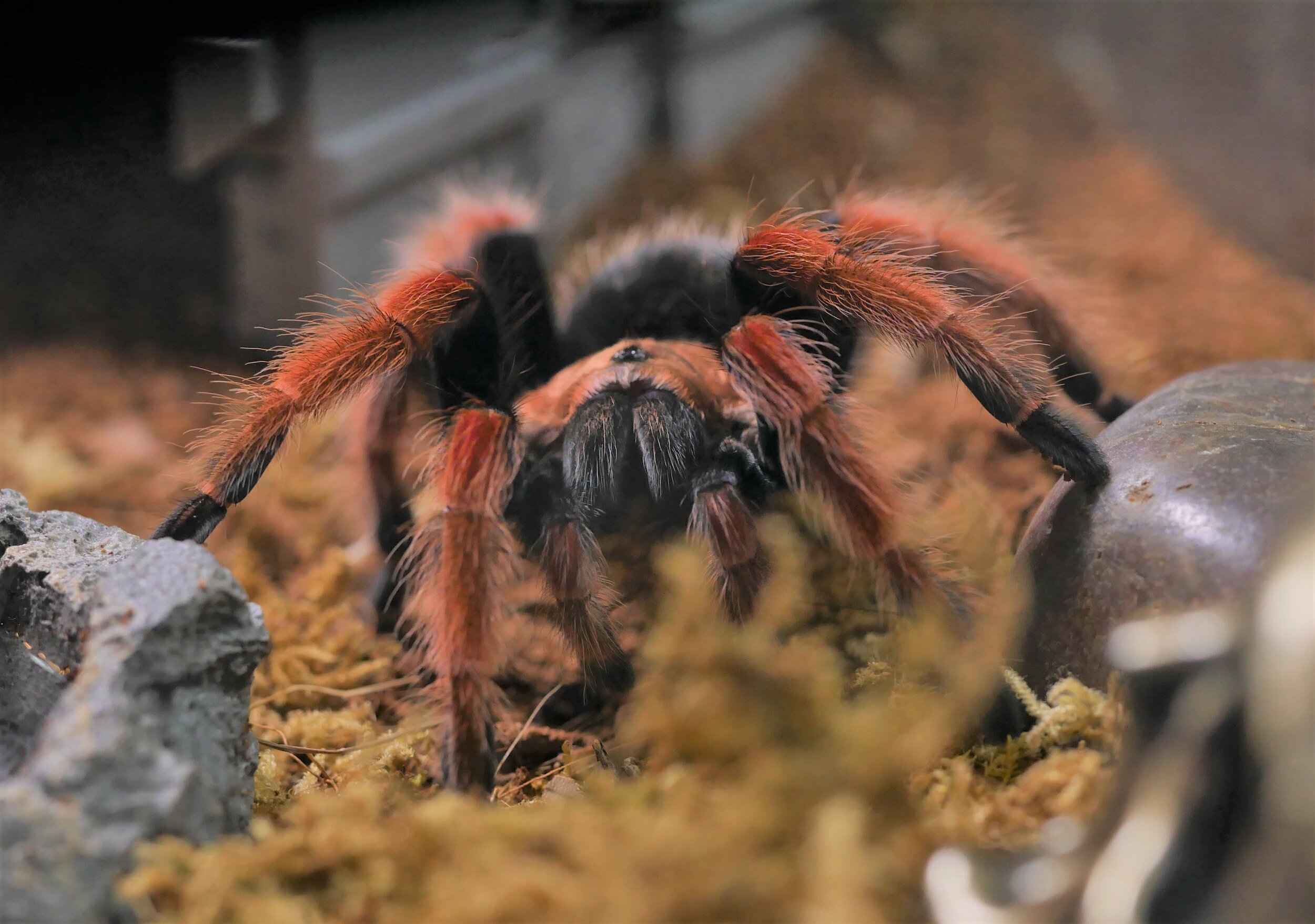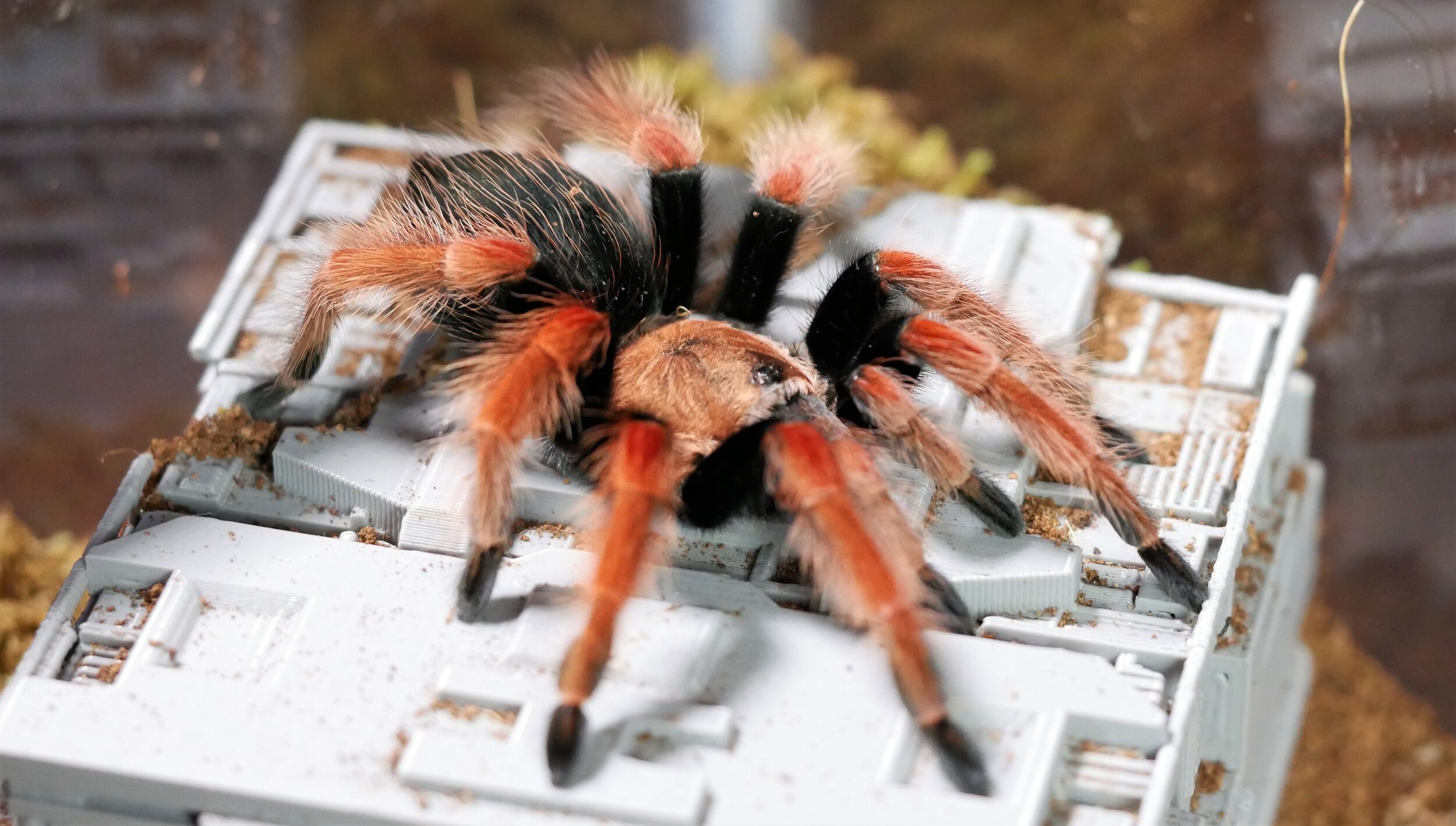Mexican Fireleg Tarantula
Brachypelma boehmei
Care Sheet
Mexican Fireleg Care
Brachypelma boehmei Care Guide
The Mexican Fireleg / Mexican Rustleg Tarantula
Revision Date: March 2025
Introduction
Brachypelma boehmei, commonly known as the Mexican Fireleg or Mexican Rustleg Tarantula, is a striking New World terrestrial species native to Mexico (primarily Guerrero) and Belize. Recognized for its distinctive black abdomen contrasted by bright red or orange legs, this tarantula stands out visually from its relatives. Although its overall appearance is similar to other Brachypelma species, B. boehmei tends to be more defensive and skittish, with a propensity to kick its irritating Type III urticating hairs when disturbed. Its slow growth and long lifespan (up to 25 years for females and around 8 years for males) make it a popular choice for intermediate keepers seeking both a stunning display and a manageable species.
Quick Species Snapshot
Scientific Name: Brachypelma boehmei
Common Names: Mexican Fireleg Tarantula, Mexican Rustleg Tarantula
Type: Terrestrial
Category: New World
Endemic Location: Mexico (Guerrero), Belize
Body Length: Approximately 2.75” (7 cm)
Diagonal Leg Span (DLS): Approximately 6.5” (17 cm)
Urticating Hairs: Yes, Type III
Growth Rate: Slow
Life Expectancy:
Females: Up to 25 years
Males: Around 8 years
Recommended Experience Level: Intermediate
Taxonomy & Research Update
B. boehmei is one of several species within the Brachypelma genus that have long been popular in the hobby. Although it shares many similarities with species like B. hamorii and B. smithi, the unique leg coloration and pattern of B. boehmei help distinguish it. Described in 1993 by Schmidt & Klass, this species has established itself as a reliable, long‑lived tarantula. While some variability exists in coloration among specimens, the consistent trait is its striking contrast between the dark abdomen and the vibrant legs.
What Makes Brachypelma boehmei So Special?
The Mexican Fireleg Tarantula is particularly noted for its dramatic coloration, its bright red or orange legs set against a jet-black abdomen create an eye-catching contrast. However, its beauty is paired with a more defensive nature than many other Brachypelma species. This defensiveness is evident when they quickly kick their urticating hairs or bolt to safety when disturbed. Despite this, many keepers appreciate its reliable temperament once mature, making it a great ambassador for tarantula keeping despite requiring extra caution during rehousing or maintenance.
Natural Habitat & Enclosure Considerations
In the wild, B. boehmei inhabits the dry scrublands and rocky terrains of Mexico’s Guerrero State and parts of Belize. As an opportunistic burrower, it will create its burrow in available spaces, including abandoned holes or natural crevices. In captivity, replicating these conditions involves providing a deep, well‑draining substrate that allows for natural burrowing while minimizing the risk of falls, a crucial consideration given that even small falls can be hazardous for a tarantula.
Housing & Substrate – Terrestrial Setup
Spiderlings
Enclosure Size:
Use a small acrylic enclosure (e.g., Sling Crib, 3" Tarantula Cube, Small Slider Crib, Small Cuboid, Terrestrial Sling Crib, Slider Crib Mini, or Cuboid Mini) that is no smaller than three times the tarantula’s leg span. We recommend enclosures by Tarantula Cribs for their proven quality and safety.Substrate:
Fill at least 2/3rds of the enclosure with Terra Aranea by The Bio Dude.Humidity:
Maintain a slightly damp substrate (but not swampy) by offering a small water dish or gently dripping water on one corner about once a week.
Juveniles
Enclosure Size:
Use a medium enclosure (e.g., Medium Slider Crib, 6" or 8" Tarantula Cube, or Medium Cuboid) that is at least 3–4× the tarantula’s leg span.Substrate:
Fill the enclosure 1/2 to 2/3 full with Terra Aranea by The Bio Dude. This depth ensures ample space for burrowing while minimizing the risk of injury from falls.Humidity:
Keep the substrate mostly dry with a full water dish; occasionally overflow one corner to create a slightly damp area.Additional Features:
Provide a half cork bark round for a secure hide.
Adults
Enclosure Size:
Use a large enclosure (e.g., Large Slider Crib, 12" Cube Switch, 12" Cube, 18" Cube, or Terrestrial XL) that is at least 3× the tarantula’s leg span (ideally 4× for enhanced natural behavior, while considering escape risks). Enclosures by Tarantula Cribs are highly recommended.Substrate:
Fill the enclosure 1/2 to 2/3 full with Terra Aranea by The Bio Dude to provide sufficient depth for burrowing while reducing the risk of falls.Additional Features:
Include a secure hide (preferably a half cork bark round) and a shallow water dish. Ensure the enclosure is a horizontal rectangle (wider than it is deep) with secure ventilation and a tight, secure lid to prevent escapes.
Note:
The general rule of thumb for tarantula enclosures is that the enclosure should be no smaller than three times the tarantula’s leg span for spiderlings, 3–4× for juveniles, and 3–4× for adults. This ensures ample space for natural burrowing while minimizing fall risk. Remember, tarantulas are escape artists, so always verify that ventilation holes, lids, and gaps are too small for your tarantula to squeeze through. They can and will climb glass and other smooth surfaces.Affiliate: Please use Tarantula Cribs (affiliate code TTC10) and Terra Aranea by The Bio Dude for substrate.
Temperature & Humidity
Temperature: Maintain ambient temperatures between 68°F and 76°F (20°C to 24°C).
Humidity: Aim for moderate humidity. Ensure that the substrate remains moist in the lower layers to support natural burrowing while allowing the top layers to dry between waterings to prevent mold growth.
Feeding Schedule
Spiderlings
Frequency:
Feed twice a week.Prey:
Offer small prey such as flightless fruit flies, confused flour beetles, or pre-killed tiny crickets/roach nymphs. Remove any uneaten prey after 24 hours. increase the size of the prey as the spider grows. Prekill any prey that is over 2/3 the size of the sling. For more detailed information on feeding spiderlings, watch this video: How To Feed Spiderlings & Scorplings (Baby Tarantulas & Scorpions)Post-Molt:
Wait 24–48 hours after a molt before feeding. Ensure that the tarantula’s fangs are solid black and its exoskeleton is not soft or shiny.
Juveniles
Frequency:
Feed every 7–10 days.Prey:
Provide 2–3 small to medium crickets or a medium Dubia roach.Feeding Guidelines:
If the abdomen is thinner than the widest part of the carapace, feed more prey more often.
If the abdomen is wider than the carapace, feed less prey, less often.
This strategy helps prevent obesity, which can lead to molting complications or increase the risk of an abdomen rupture from even a small fall.
Post-Molt:
Wait 3–7 days after a molt before feeding, ensuring that the tarantula’s fangs are solid black and its exoskeleton is fully hardened.
Adults
Frequency:
Feed every 2–3 weeks (or as needed).Prey:
Offer 4–5 large crickets or one large Dubia roach.Feeding Guidelines:
If the abdomen is thinner than the carapace’s widest part, increase feeding frequency.
If the abdomen is wider than the carapace, reduce feeding frequency.
This is crucial to avoid obesity, which can interfere with proper molting or cause dangerous issues such as an abdomen rupture.
Post-Molt:
Wait 5–10 days after a molt before feeding, ensuring that the tarantula’s fangs are solid black and its exoskeleton is fully hardened.
Behavior & Temperament
The Mexican Fireleg Tarantula is known for its distinctive coloration, with a striking black abdomen and bright red or orange legs. It tends to be more defensive and skittish compared to other Brachypelma species, often kicking its urticating hairs when disturbed and bolting short distances when threatened. Although it can be handled by experienced keepers, caution is paramount due to its speed and potent irritant hairs. Generally, as an adult, it is a powerful and impressive display species that rewards careful observation with its vibrant colors and dynamic behavior.
Breeding Brachypelma boehmei in Captivity
Breeding Brachypelma boehmei (Mexican Fireleg Tarantula) requires patience due to their slow growth and selective mating behavior. As a CITES-protected species, captive breeding is crucial to keep this strikingly beautiful tarantula available while ensuring wild populations remain untouched.
Sexual Maturity & Pairing
Male Maturity: Males mature in 4–7 years, developing tibial hooks and enlarged pedipalps for sperm transfer.
Female Maturity: Females take longer, often 8–12 years, before reaching reproductive maturity.
Pre-Pairing Preparation: We should ensure the female is well-fed before pairing to prevent defensive responses. Some breeders have better success when slightly increasing humidity before pairing to mimic seasonal breeding cues.
Mating Process
Introduce the male at night, when tarantulas are more likely to engage in mating behavior.
The male will drum on the substrate to signal his presence.
If receptive, the female will drum back or remain still, allowing the male to lift her with his tibial hooks and insert his emboli.
Once mating is complete, the male should be removed immediately, as B. boehmei females can become defensive afterward.
Egg Sac Production
If fertilization is successful, the female will begin producing an egg sac 4–6 months after mating.
Maintain temperatures around 72–78°F (22–25°C) with humidity levels of 60–70% to support egg sac development.
The egg sac typically contains 400–800 eggs, but clutch sizes may vary.
Egg Sac Handling (Optional)
Some breeders prefer to pull the egg sac after 30–45 days for artificial incubation.
If left with the mother, 1st instar spiderlings will emerge in 8–10 weeks, molting into 2nd instar within 3–4 weeks.
Raising Spiderlings
Once the spiderlings reach 2nd instar, we should separate them into individual enclosures.
Feed them pinhead crickets, flightless fruit flies, or small roaches every 3–4 days.
Maintain moderate humidity while allowing part of the enclosure to dry out between mistings to prevent mold growth.
Challenges & Considerations
Female selectiveness: Some females may reject males outright, requiring multiple introductions before successful pairing.
Long maturation time: Due to slow growth rates, breeding B. boehmei is a long-term commitment requiring patience.
Male lifespan: Males typically do not live beyond a year after maturing, so breeding attempts should be made as soon as possible.
As a CITES-protected species, Brachypelma boehmei should never be taken from the wild. By focusing on captive breeding efforts, we help preserve wild populations while ensuring this incredible tarantula remains available to keepers. Every successful breeding project strengthens the future of this species in the hobby, reducing demand for wild-caught specimens and promoting ethical, sustainable practices.
Final Thoughts
Brachypelma boehmei (Mexican Fireleg Tarantula) is a visually stunning and hardy species that makes an excellent addition to any collection, especially for intermediate keepers. Its unique color pattern, combined with a robust and defensive nature, sets it apart from other Brachypelma species. With proper husbandry, including an enclosure with substrate filled half full (to ensure sufficient burrowing depth while minimizing fall risk), controlled humidity, and a balanced feeding routine adjusted based on abdomen size, you can help ensure your tarantula remains healthy and vibrant for many years.
Additional Recommendations:
For enclosures, consider Tarantula Cribs with the affiliate code TTC10 for a 10% discount, and use Terra Aranea by The Bio Dude for substrate. For purchasing tarantulas and supplies online, check out Spider Shoppe (use code TTC10 for 10% off). Also, visit the Dealer & Discounts section on my website for a curated list of recommended dealers and discount codes.
Additional Scientific Information
Taxonomic Insights:
Described in 1993 by Schmidt & Klass, Brachypelma boehmei is closely related to species like B. hamorii and B. smithi, but is distinguished by its unique leg pattern and coloration. Ongoing research continues to refine our understanding of these differences, which can be subtle yet important for proper identification.Ecological Role & Adaptations:
In its natural habitat in Mexico and Belize, B. boehmei inhabits dry scrublands and rocky areas where it is an opportunistic burrower. Its robust build and defensive behavior help it survive in these arid environments. In captivity, replicating its natural habitat with a deep, well-draining substrate and controlled humidity is key to its long-term health.Feeding & Health Management:
Overfeeding is a common concern with tarantulas. To prevent obesity—which can lead to molting complications or even an abdomen rupture from a small fall—monitor the tarantula’s abdomen relative to its carapace. If the abdomen is thinner than the carapace’s widest part, more frequent feedings are warranted; if it is wider, reduce the feeding frequency. Always wait until the tarantula’s fangs are solid black and its exoskeleton is fully hardened before feeding (post-molt waiting times: Spiderlings: 24–48 hours, Juveniles: 3–7 days, Adults: 5–10 days).
(For further reading, consult recent studies in the Journal of Arachnology and ZooKeys for detailed taxonomic and ecological insights on New World Theraphosidae.)





























